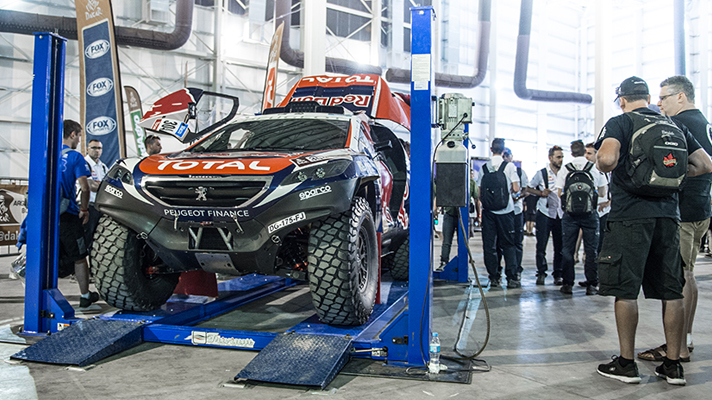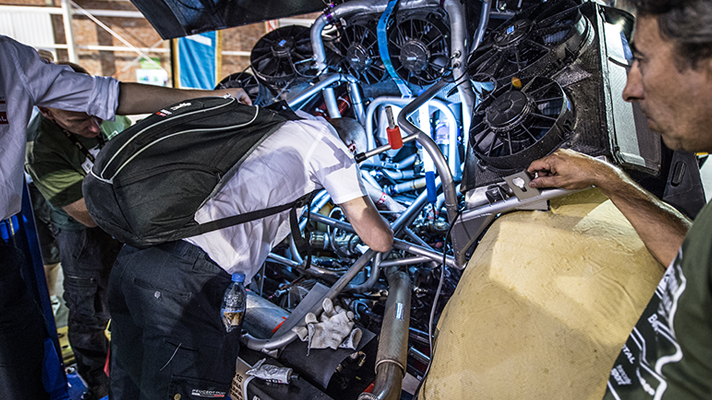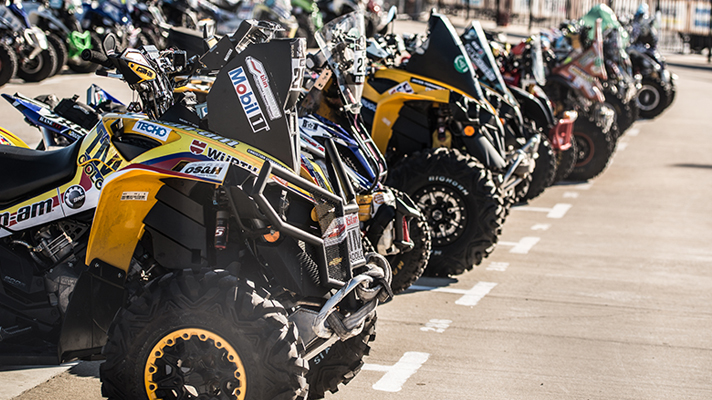
Dakar Rally 2015: pre-race scrutineering
Top Gear has been following the story of Peugeot’s new revolutionary rally raider – the 2008 DKR – since its conception.
However, the pre-race scrutineering was actually the first time that we, and the ASO Dakar officials, had seen the triplet of race cars for the first time. Now, before you think we’re going mad, the 2008 DKR we witnessed yomp its way across the Moroccan desert to the very literal point of destruction last month was just the development car.
The Peugeot Sport team actually waited for the drivers to squeeze the final drops of information from the development car before committing to a final set up and build in Paris. That was three weeks ago. So it’s safe to say the mechanics have been working their, and the cars’, nuts off to build three racers and ship them half way across the world in time for the race.
On Friday afternoon all three were wheeled into a giant fluorescent strip-lit hall in the Technopolis, a science centre on the fringes of Buenos Aires’ city centre. That’s where they were handed over to stern looking French officials wearing Kim and Aggie spec white gloves. However, the biggest critics – the public – were also in attendance, camera phones at the ready to social media the tears of very tired Peugeot Sport employees if their hard work was for nothing and the cars were deemed unfit to race.
And this wasn’t a quick “cup of the balls” and cough kind of examination. Everything – and we mean everything – was scruitnised with a fine-tooth comb. And because the car is a clean-slate project with a new kind of design, it took well over two hours for each car.
The reason being, the car has utilised all the nous from Peugeot Sport's portfolio of previous projects - WRC, Le Mans and Pikes Peak – and incorporates a new mindset, philosophy and design which created a palpable anxious tension in the air.
Why? Because unlike most top-level competitors, Peugeot has not opted for a four-wheel-drive layout. Instead, all the power from the ridiculously mid-mounted 340bhp, V6 twin-turbodiesel engine goes to the rear wheels. This means there are less ‘driving bits' (TG technical term) to break but also puts the 2008 DKR into a different class, loosening up the restricting regulations that dominant four-wheel-drive competitors face in the process.
Technically, being a buggy compared to the four-wheel-drive cars, Peugeot are allowed a hell of a lot more suspension travel (460mm against 250mm), bigger wheels, less minimum weight. and a trick inboard remote tyre-pressure system that allows the car to inflate/deflate its rubber on the move.
Because of the smaller-than-normal proportions, the packaging is pretty special. Borrowing ideas from the 908 Le Mans car, the gearbox is actually part of the chassis, with the suspension is mounted directly to it. The engine is in the middle of the car, webbed with wires, exhausts and surrounded with six fans that cool the dampers, radiators and an intercooler. All of much interest to the regulation box tickers.
And after a lot of waiting and a bit of sweating, all three cars – and the monstrous support crew that’s subjected to the same extensive examination – were given the green light and sent to Parc Ferme to sit under a plastic veil.
Top Gear
Newsletter
Thank you for subscribing to our newsletter. Look out for your regular round-up of news, reviews and offers in your inbox.
Get all the latest news, reviews and exclusives, direct to your inbox.
We’re not exactly sure why they were under a translucent cover, as it was the only car that was. But given that the amount of slack-jawed punters staring in awe of them, it was probably to stop them being covered in South American slobber…










